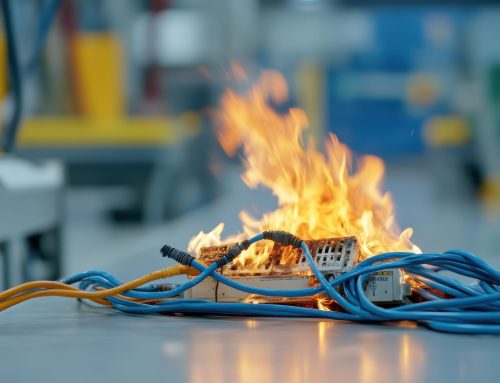Holiday travel season is here. Would you know what to do if a fire broke out on your flight? Do you know what measures are in place to keep passengers safe?
How are in-flight fires prevented?
Cabin airplane fires are one of the most dangerous situations a flight crew can face. An in-flight fire can lead to the loss of the aircraft within a short amount of time. Flight crews must take assertive action. Data from a UK CAA report in 2002 found that from the first indication of an onboard fire, the crew has on average 17 minutes to get the aircraft on the ground.
Research also shows that an unconfined fire can destroy an aircraft in as few as 20 minutes. Fire can completely consume a smoke-filled cabin in as few as 6-10 minutes. Time is critical when fighting in-flight fires.
Crew members should first use a portable fire extinguisher when fire is visible within the cabin. The goal is to extinguish the fire as fast as possible to prevent toxic smoke and fumes from spreading through the aircraft. Halon fire extinguishers are most commonly used on aircrafts since halon is a multipurpose (extinguishes classes A, B, & C fires) agent.
Most commercial aircraft have the following fire detection/firefighting equipment:
- Smoke detectors– Optical smoke detectors are installed in the lavatories and cargo compartments.
- Portable fire extinguishers– Portables are stored in the cabin and cockpit of the airplane.
- Automatic fire extinguishing systems– Type of system will vary by aircraft; some planes have automatic suppression systems while others have manual systems.
- Insulated crowbars– These tools can be used to locate hidden fires; typically stored in the cabin/cargo compartment.
- Fire protection gloves– Gloves are kept in the flight deck and protect against heat/fire.
- Smoke protection devices– Devices vary by cabin; Protective Breathing Equipment (PBE) or a Smoke Hood provides passengers with oxygen for a short amount of time.
- Fire blankets– Some flights are equipped with fireproof blankets used to suffocate smaller fires.
All aircraft is required to have emergency equipment for fire extinguishment. Crewmembers can also use other means to extinguish fires. Non-flammable liquids can extinguish small fires like those caused by electronic devices. Extinguishing these fires is important to prevent battery cells from reaching thermal runaway (which can cause an explosion).
What are the most common areas for airplane fires?
Airplane fires can occur in varying places, and for varying reasons. Airplane fires are typically categorized into three types: engine, cabin, and hidden.
- Engine fires– Excess oil spills and igniting are the most common causes of engine fires. Fuel leaks or pressurization within the engines’ piping also cause fires. Engines have their own fire suppression and containment systems. The pilot can spool down/switch off fuel to engines on fire. Engine fires are rare and fairly simple to address. The crew can use fire extinguishers on the engine after the fuel supply is shut off.
- Cabin fires– There are a few causes of in-flight, or cabin, fires such as wiring failures, electrical component failures, lithium Ion batteries, and faulty circuit protection. There are several types of cabin fires: galley fires, electrical fires, lavatory fires, waste container fires, seat fires, and passenger PED fires. Many cabin fires are a result of human error (i.e. overheated food items in the galley or improper storage of Lithium batteries in PEDs).
- Hidden fires– Hidden fires are fires not easily accessible and challenging to extinguish (i.e. a fire behind sidewall paneling or in overhead areas). Overhead areas contain the aircraft’s entertainment system, numerous wiring bundles, control surface cables, portions of the air conditioning system, passenger oxygen system, and other systems. Any of these components malfunctioning can result in a fire in the overhead compartment. In most cases, electrical arcs along wire bundles cause hidden in-flight fires. The electrical arc acts as the initiating event, igniting other surrounding materials.
What can passengers do to prevent in-flight fires?
Notify a crew member immediately if you see fumes, smell smoke, see smoke coming from vents, or interior panels of the aircraft,
You may be asked to help combat a fire if you are an able-bodied passenger. Crew members seek out all available resources to extinguish smaller in-flight fires.
As always, prevention is key. For passengers, this means adhering to all rules while onboard (i.e. not smoking or using e-cigarettes) and properly storing personal electronic devices. Finally, TSA has an online “travel checklist” that will help passengers know what to pack and how it pack it.






